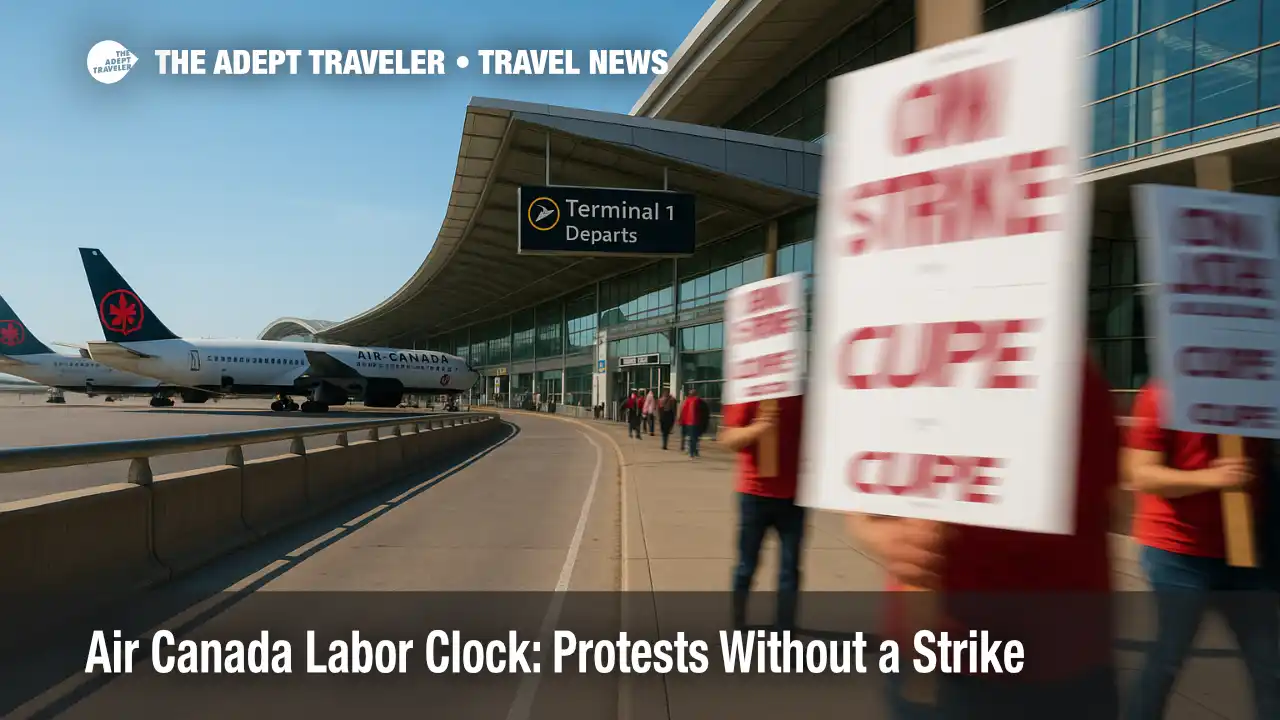Air Canada Labor Clock: Protests Without a Strike

Air Canada's flight attendants, represented by CUPE, staged coordinated protests on August 11, 2025 at four airports while federally mediated talks continued. Flights operated normally as members highlighted unpaid ground duties and sought higher wages. Under Canada's labor rules, a 72-hour strike notice can be issued only after the cooling-off period that follows conciliation and mediation. The air canada labor clock now hinges on whether CUPE files that notice, which would start a three-day countdown to a legal walkout.
Key Points
- Why it matters: A strike could disrupt peak summer schedules nationwide.
- Travel impact: Operations remained normal during the protests.
- What's next: A 72-hour notice would trigger any walkout.
- Four hubs involved, YYZ, YUL, YVR, and YYC hosted informational pickets.
- Core dispute, pay for ground time and scheduling rules.
Snapshot
CUPE organized a national "day of action" on August 11 to spotlight compensation and scheduling concerns without stopping work. National outlets described informational pickets at Toronto Pearson International Airport (YYZ), Montréal-Pierre Elliott Trudeau International Airport (YUL), Vancouver International Airport (YVR), and Calgary International Airport (YYC). The union says attendants perform essential tasks when aircraft are parked that are not fully compensated. Air Canada said it expected normal operations during the demonstrations and continued to participate in mediated talks. Earlier coverage on our site tracks the lead-up to this phase in Air Canada Flight Attendants Vote on August Strike and Air Canada Flight Attendants Approve Strike Mandate. The next move is procedural, not symbolic, with the legal option to file a 72-hour notice if mediation fails.
Background
Talks moved from conciliation into mediation after the parties reported an impasse. Canada's framework requires several steps before a strike is lawful, including a successful strike vote, a 21-day cooling-off period, and a 72-hour notice to both the employer and the Minister. Amendments that took effect on June 20, 2025 added a maintenance-of-activities process and limits on replacement workers during strikes and lockouts. CUPE says more than 10,000 flight attendants at Air Canada and Air Canada Rouge are affected, with pay, unpaid duties, and scheduling among top issues. Air Canada has said it seeks a competitive agreement that supports long-term growth while keeping operations reliable for travelers during the busy summer period.
Latest Developments
Airport Protests Keep Pressure On, Flights Run Normally
CUPE organized coordinated pickets at YYZ, YUL, YVR, and YYC at set times to maximize visibility while avoiding operational interference. Media on the ground reported no flight cancellations linked to the events, and Air Canada said it expected schedules to run as planned. Union messages focused on pay for boarding, safety checks, and deplaning, along with rest rules and cost-of-living pressures. The actions were framed as informational protests, not a strike, and were intended to remind management that a legal walkout remains possible if talks stall. The airline reiterated its goal to reach a fair deal through mediation, and to keep customers informed if any formal labor notice changes the operating plan.
What The Air Canada Labor Clock Allows Next
Under federal rules, the right to strike arises only after conciliation ends, the 21-day cooling-off period elapses, and a formal 72-hour notice is served to both the employer and the Minister. Mediation can continue during this window. As of June 20, 2025, employers and unions must also have a maintenance-of-activities agreement in place before notice is issued, or a decision from the Canada Industrial Relations Board. Practically, the earliest lawful strike date is three days after any notice is delivered. That timing is controlled by statute, not by protest dates or public statements, which is why any filing, if it comes, is the decisive signal for travelers monitoring potential Air Canada strike risk.
Analysis
For now, this is a statutory timing story rather than an operational one. CUPE's mandate increases leverage, but it does not permit a walkout until procedural gates are cleared. The air canada labor clock is shaped by the cooling-off period, maintenance-of-activities requirements, and the 72-hour notice. If the union files notice soon after mediation concludes, disruption could land inside the late-summer peak, a period with limited spare capacity. Operational risk concentrates at Toronto Pearson International Airport (YYZ) and Montréal-Pierre Elliott Trudeau International Airport (YUL), which anchor domestic, transborder, and trans-Atlantic connectivity. Vancouver International Airport (YVR) and Calgary International Airport (YYC) extend exposure to Pacific and Western Canada flows. Airlines typically avoid preemptive schedule changes until a notice appears, then pivot to protection plans. For travelers, the practical indicator will be a formal notice and any subsequent advisory from booking channels, not the presence of picket lines.
Final Thoughts
Protests raised visibility without halting flights, and mediation continues under federal oversight. The next meaningful event is a formal 72-hour notice, which would start the countdown to a possible walkout. If that notice arrives, act early on rebooking, favor earlier departures, and build longer connections to preserve options. In the absence of a notice, operations should remain stable, and travelers can expect normal schedules. Watch announcements closely, because disruption risk will be dictated by the air canada labor clock.
Sources
- Air Canada pay talks intensify as cabin crew protest, threaten strike, Reuters
- Air Canada flight attendants to picket at four Canadian airports, Reuters
- Air Canada flight attendants organize national action to protest working conditions, Reuters
- Collective Bargaining, Government of Canada Labour Program
- Replacement workers legislation now in force, Government of Canada
